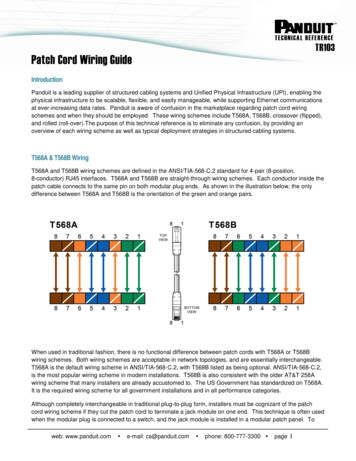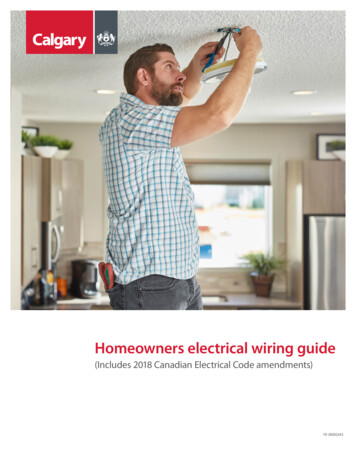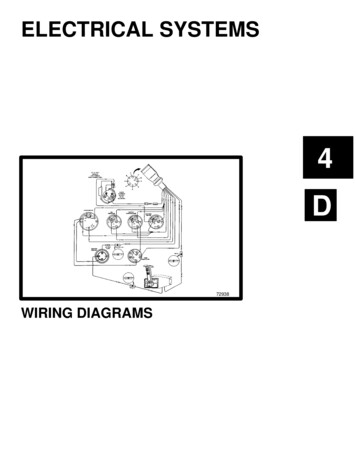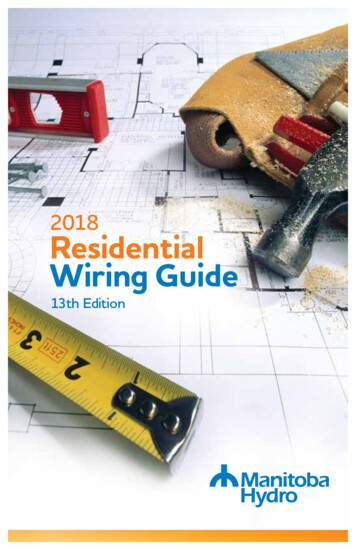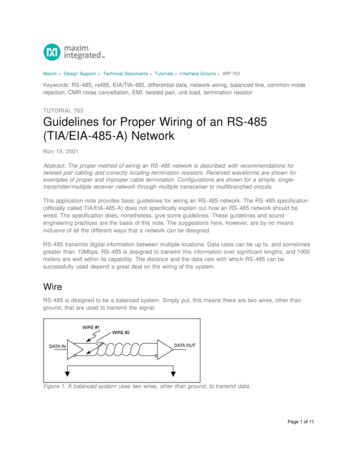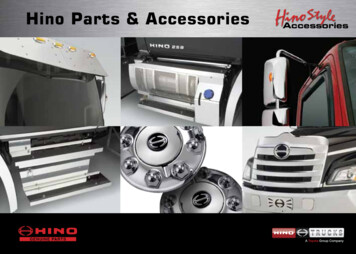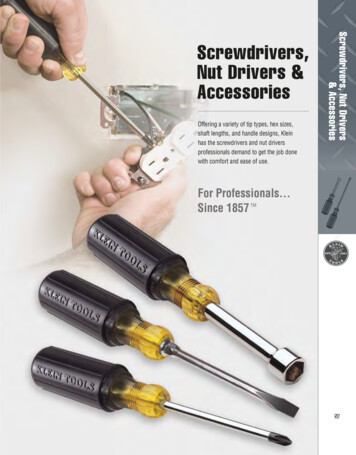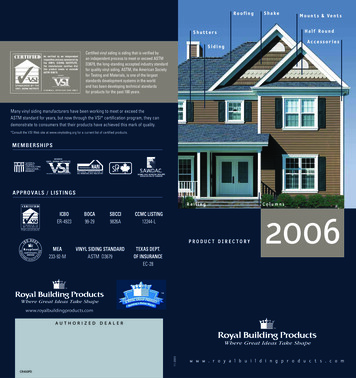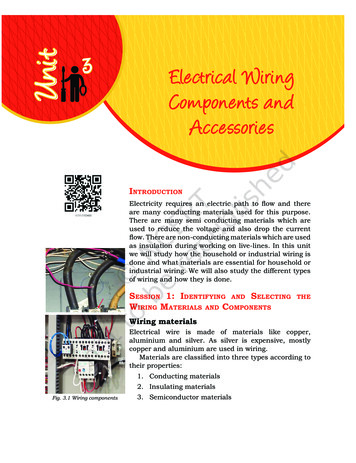
Transcription
3Electrical WiringComponents andAccessoriesIntroductionElectricity requires an electric path to flow and thereare many conducting materials used for this purpose.There are many semi conducting materials which areused to reduce the voltage and also drop the currentflow. There are non-conducting materials which are usedas insulation during working on live-lines. In this unitwe will study how the household or industrial wiring isdone and what materials are essential for household orindustrial wiring. We will also study the different typesof wiring and how they is done.Session 1: Identifying and SelectingWiring Materials and ComponentstheWiring materialsElectrical wire is made of materials like copper,aluminium and silver. As silver is expensive, mostlycopper and aluminium are used in wiring.Materials are classified into three types according totheir properties:1. Conducting materials2. Insulating materialsFig. 3.1 Wiring componentsUnit-3 Electrical Wiring Components and Accessories.indd 423. Semiconductor materials17-Mar-21 3:04:06 PM
Conducting Material(a) CopperIt is a good conductor of electricity. It is used in wiringmaterials in cables. Its has low resistance and is usedfor conduction of electricity at high, medium and lowvoltage (Fig. 3.2).It is used in wiring and cable making.Fig. 3.2 Copper wire(b) AluminiumIt is light weight and cheaper in comparison to copper.Therefore, this type of conducting material is mostlyused in electrical wiring. It is silvery–white in colourand it has a soft texture. It is often used in wiring andmaking cable (Fig. 3.3).Fig. 3.3 Aluminium wireInsulating MaterialsInsulating materials are used for insulating purpose.These types of materials are bad conductors of current.For example rubber, paper, mica, wood, glass andcotton.Wiring AccessoriesWiring accessories are used for connecting appliances(Fig. 3.4).(a) SwitchA switch is used to make or break an electrical circuit.It is used to switch ‘on’ or ‘off ’ the supply of electricityto an appliance.There are various switches such asyy surface switchyy flush switchyy ceiling switchyy pull switchyy push button switchyy bed switchFig. 3.4 Sockets(i) Surface switch: It is mounted on wooden boards fixedon the surface of a wall. It is of three types1. One-way switch2. Two-way switch3. Intermediate switchElectrical Wiring ComponentsandAccessories43Unit-3 Electrical Wiring Components and Accessories.indd 4311-06-2019 12:56:23
Fig. 3.5 One-way switchyy One-way switch: It is used to control single circuitsand lamp (Fig. 3.5).yy Two-way switch: It is used to divert the flow ofcurrent to either of two directions. The two-wayswitch can also be used to control one lamp fromtwo different places as in the case of staircase wiring(Fig. 3.6).yy Intermediate switch: It is used to control a lampfrom more than two locations (Fig. 3.7).(i) Flush switch: It used for decorative purpose (Fig. 3.8).(ii) Bed switch: As the name indicates, it is used toswitch ‘on’ the light from any place, other than switchboard or from near the bed. This switch is connectedthrough a flexible wire (Fig. 3.9).(b) HoldersA holder is of two types.Fig. 3.6 Two-way switch1. Pendant holder (Fig. 3.10)2. Batten holder (Fig. 3.11)Fig. 3.10 Pendant holder(c) Ceiling roseIt is used to provide a tapping to the pendant lamp–holder through the flexible wire or a connection to afluorescent tube (Fig. 3.12).Fig 3.7 Intermediate switchFig. 3.8 Flush SwitchFig. 3.9 Bed switch(d) Socket outlet/plugThe socket outlet has an insulated basewith the moulded or socket base havingthree terminal sleeves (Fig. 3.13).Fig. 3.13 Socket(e) Main switchTo control the electrical circuit a main switch is used.Through the main switch, the power in a building iscontrolled completely (Fig. 3.14).Fig. 3.11 Batten holderFig. 3.12 Ceiling roseFig. 3.14 Main switch/Main MCBCable Jointer — Electrical Power System — Class XI44Unit-3 Electrical Wiring Components and Accessories.indd 4411-06-2019 12:56:30
(f) PVC casing-capping wiringPVC capping is done in order to cover the wires. Itincludes casing also. This casing-capping wiring is alsoknown as open wiring, as it is done outside the wall.Materials required for PVC casing-capping wiring(Figs. 3.15 and 3.16) include1. wire2. casing enclosures made up of plastic3. capping made up of plastic4. T. Joints VIR (Vulcanised Indian Rubber) orPVC (Polyvinyl chloride) insulated wire5. junction box6. elbow7. casing and capping jointsWooden casing-capping wiring is old fashioned. NowPVC or VIR insulated wires are enclosed within thePVC casing enclosure and PVC capping is used to coverthe casing.Fig. 3.15 PVCcasing-capping accessoriesFig. 3.16 PVCcasing-capping bendAdvantages of casing-capping wiringyy Easy to installyy Strong and durable wiringyy Customization can be done easilyyy Safe from smoke, dust, rain and steam, etc.yy No risk of shock due to casing and capping,Disadvantages of PVC casing-capping wiringyy Costlyyy Not suitable for humid weatheryy High risk of fireMiniature Circuit Breaker (MCB)A MCB is used in new constructions instead ofthe older types of fuses. Circuit breakers are smalldevices used to control and protect the electrical paneland the other devices from overflowing of electricalpower (Fig. 3.17).Uses of MCBHome electrical panelsAs with all breakers, the MCB is designed to protectthe house from circuit overload. An MCB is much saferElectrical Wiring ComponentsandFig. 3.17 MCB DistributionBoxAccessories45Unit-3 Electrical Wiring Components and Accessories.indd 4511-06-2019 12:56:32
than the typical fuse, because it can be reset manuallyand can handle larger amounts of power. The breakercan manage the flow of energy, distributing the voltageeven when many devices run off the same power circuit.LightsMCBs are used in the lighting system of the house,because they can deal with the amount of power neededto lightening a house, especially if specific types of lamps,such as fluorescent lights are used. MCBs overcome theneed of additional power required when switching onthe lights, especially when lights are used extensively inthe entire house.Industrial applicationsThere are many small scale industrial buildings whereMCBs are used instead of the old fuses. Miniature circuitbreakers are largely used in restaurants, bakeries andcommercial food stores.HeatersWhen heaters are used at home or in the office, the MCBcan be beneficial. It is known in general that heaters canbe problematic sometimes, especially with distributionof electrical power. The MCB prevents possible problems,cutting off electricity in the case of overload or fault.In this case, though, you need to choose a miniaturecircuit breaker of the proper capacity, enabling it tohandle the load of power when needed.Conduit WiringFig. 3.18 Conduit wiringElectrical conduits are used to protect and provide theroute of electrical wiring in an electrical system. Electricalconduits are made of metal, plastic, or fibre and canbe rigid or flexible. Conduits (Fig. 3.18 and 3.19) mustbe installed by electricians as per standard regulations.For workshops and public buildings, conduit wiring isthe best and most desirable system of wiring. It providesprotection and safety against fire.Types of Conduits1. Class A conduit: Thin layered steel sheet oflow gauge2. Class B conduit: Thick steel sheet of high gaugeCable Jointer — Electrical Power System — Class XI46Unit-3 Electrical Wiring Components and Accessories.indd 4611-06-2019 12:56:32
Materials used in Conduit WiringyyyyyyyyGI (Galvanised Iron) wireElbowCouplingVIR (Vulcanized Indian Rubber) or PVC (Poly VinylChloride) insulated cablesyy Lock nutyy Clipyy Junction BoxAdvantages of conduit wiringyy Safeyy Better appearanceyy No risk of fireyy No risk of damage of cable insulationyy Safe from humidity, smoke, steam, etc.yy No risk of shockyy Long lastingDisadvantages of conduit wiringyy Expensiveyy Installation is not easyyy Not easily customisable for future useyy Hard to detect faults2 way Conduit1 way Conduit3 way ConduitFig. 3.19 Conduit wiring componentsConcealed WiringIt is laborious to install this wiring. The layout of thiswiring is done under the plaster of the wall of thebuilding.Advantages of concealed wiringyy Safeyy Better appearanceyy No risk of fireyy No risk of damage of cable insulationyy Safe from humidity, smoke, steam, etc.yy No risk of shockyy Long lastingDisadvantages of concealed wiringyy Expensiveyy Installation not easyyy Not easily customisable for future useyy Hard to detect faultsElectrical Wiring ComponentsandAccessories47Unit-3 Electrical Wiring Components and Accessories.indd 4711-06-2019 12:56:33
Colour CodeWiring for AC and DC circuit are colour coded foridentification of individual wires (Table 3.1).Table 3.1 AC power circuit wiring colour codesFunctionLabelNew colourOld colourProtective groundPGGreen or green-yellowGreenNeutralNWhiteGrayLine, single phaseLBlack or redLine, three phaseL1BlackBrownLine, three phaseL2RedOrangeLine, three phaseL3BlueYellowCheck Your ProgressA. Fill in the blanks1. Wiring material is of three types ,and .2. A switch is used to make or break .3. Open wiring is also known aswiring.4. are devices used to control and protectthe electrical panel from overflowing electrical power.B. State whether the following statements are True or False1. Silver is a bad conductor of electricity.2. Switches are made of conducting material.3. PVC casing and capping are used for covering the wires.C. Multiple choice questions1.Concealed wiring is immune to(a) humidity(b) heat(c) light(d) dustCable Jointer — Electrical Power System — Class XI48Unit-3 Electrical Wiring Components and Accessories.indd 4811-06-2019 12:56:33
2.3.Pendant holder is used for(a) fixing the bulb(b) fixing the fan(c) for hanging the bulb(d) to hang the fanA two-way switch is used for(a) control one bulb from 2 points(b) control two bulbs from 2 points(c) control multiple bulbs from 2 points(d) control one bulb from one pointD. Short answer questions1. Why is PVC casing-capping preferred over woodencasing-capping wiring?2. How does an MCB help in managing electrical power?3. Why is conduit wiring used in homes?4. Discuss the importance of colour codes in electricalwiring.Session 2: ICTP SwitchBoardandDistributionICTP (Iron Clad Triple Pole) SwitchIt is used alongwith the energy meter to isolate thesupply of electricity automatically or manually (Fig. 3.20).Fig. 3.20 ICTP switchDistribution BoardA distribution board is a component of an electricitysupply system that divides an electrical power feed intosubsidiary circuits, while providing a protective fuse orcircuit breaker for each circuit in a common enclosure.A distribution board is also known as panelboard,breaker panel, or electric panel (Fig. 3.21).Electrical CircuitIn an electric circuit the positive side of wire is connectedto the negative side of a load, for example, bulb, TV,etc. and power supply is started by using a switch. Thecircuit is like an electrical house.Electrical Wiring ComponentsandFig. 3.21 MCB distribution boardAccessories49Unit-3 Electrical Wiring Components and Accessories.indd 4911-06-2019 12:56:36
NotesTypes of Circuit1. Open3. Closed4. Series5. Parallelyy Series circuit: It is like a stair-case. In this typeof circuit r1, r2, r3 are resistances connected inseries. In this,R r1 r2 r3where R is equivalent to resistance.yy Parallel circuit: When various resistances areconnected in parallel, then it is called a parallelcircuit. Like if r1, r2 and r3 are connected inparallel, then1/R 1/r1 1/r2 1/r3In this, all resistances having positive sides areconnected on one end and all negative sides areconnected on another end. In this, voltages are same inall the branches.Fixing Wiring Accessories on BoardYou should know the tools required for fixing theaccessories on the board. You should also know thepurpose of fixing the accessories.In-house wiring of the switches, holders and socketsshould be fixed on wooden/sunmica boards and blocks.Therefore, it is necessary to learn how to fix theseaccessories. The ways to fix these accessories have beendiscussed in the following practical activity.Let’s Practice 1Adjust the electrical accessories like, switches, holders, sockets,etc. on the given board or round block. And then mark theirpositions by a pencil. Remove the covers of the accessories andloosen the screws of terminals. Make a powder of chalk and pourit in the holes of the terminal. Mark the point on them by thepoker.Now make the holes on the round block or board by thedrilling machine where the points have been marked. Insert thewires in the terminal, after removing the insulation. Then fix allCable Jointer — Electrical Power System — Class XI50Unit-3 Electrical Wiring Components and Accessories.indd 5011-06-2019 12:56:36
the accessories on the board or round block by wooden screwsafter making holes on them by the poker. Then fix all covers onthe accessories.NotesTools and materials requiredTools1.2.3.4.5.6.7.8.Hand drilling machine with a drift bit of 5 centimeterPokerScrewdriverConnector screwdriver 8 cmsCombination plier 15 cmTry squareFirmer chisel 20 mmElectrician knife 10 cmMaterial1. Wooden round block/ PVC Round Block2. Wooden board/ Sun mica Board3. Single pole one-way switch 5 A, 250V4. PVC wire5. Pencil6. ChalkPrecautionsAll the fittings (switch, holder) should be fitted well. No nakedportion of the conductor should remain visible. The screwsin the accessories fitted should be tight. The tools should beused carefully.How to control a lamp from twodifferent places by 2-way switches?NS1 SPDT 2-WayPSingle Way Switch2-wayswitchS2 SPDT 2-WayNIntermediate 2-wayswitchswitchL N–LampA lamp is switched ON and switched OFF fromthree different places.Electrical Wiring ComponentsandAccessories51Unit-3 Electrical Wiring Components and Accessories.indd 5111-06-2019 12:56:37
NotesActivity 1Aim: Identify and draw the figureof various wiring materialsProcedureSee the different types of wiringmaterials as shown in thediagram as well as in classroomand draw the diagram.Activity 2Aim: Identify and connect the accessories with the wiresTools and equipment required1. Multimeter for measuring thecurrent and voltage.2. Tools like plier, screw driver willbe required.ProcedureAccessories will be connected with the help of wires.Precautions1. All connections should be tight.2. Do not touch the terminals when supply is on.Activity 3Aim : To connect different types of components with wires in ajunction box.Tools and equipment required1. Multimeter2. Tools like screw driver, plier.Procedure1. Different types of components will be connected with thehelp of wires in a junction boxPrecautions1. All connections should be tight.2. Do not touch the terminals when supply is on.Cable Jointer — Electrical Power System — Class XI52Unit-3 Electrical Wiring Components and Accessories.indd 5211-06-2019 12:56:40
NotesQuestions and AnswersState whether the following are True or False1.2.3.4.5.Conduit wiring is used in damp situations.In wiring light point neutral is controlled by switch.In three-pin plug maximum radius pin is used for phase.In conduit wiring CTS wire is used.Lead sheathed wiring age is more than conduit wiring.Activity 4Aim To familiarisethe student withthe electricalconnection ofa lamp to thesupply mains.To select theproper size ofconnecting wiresand switch for agiven load.NPSingle Way SwitchRelated informationIn a lamp, the electrical energy is converted into light. Thefunction of the switch is to turn the lamp “ON” or “OFF” bymaking and breaking the electrical circuit respectively. Theswitch should be connected to the phase wire of the supply. Itshould be connected in series with the lamp. The function of thefuse is to protect an electrical circuit against over current whichmay be caused by a fault or overloading.Apparatus and en batten/ PVC BattenLink clipsScrewsNailsInsulation tapeConnecting wiresLamp holderElectricians common hand toolsElectrical Wiring ComponentsandAccessories53Unit-3 Electrical Wiring Components and Accessories.indd 5311-06-2019 12:56:40
NotesPrecautions1. Make all the connections tight.2. Check the rating of the fuse.Procedure1. Fix the switch and lamp holder on the board.2. Connect the switch and lamp.3. Connect the circuit to the supply mains, while the mainswitch is “OFF”.4. Put “ON” the main switch.Activity 5Aim: To check the connection of the lamp by one switch (series)ApparatusLamp 100W/220V, holder, one-way switch, PVC wire 1/18 SWGetc.Tools and equipmentS.no.ParticularSpecification1.PlierSlide cutting plierCombination plier2.Screwdriver3.Phase testerQuantity1116”1ProcedureTake a PVC 1/18 SWG wire about 1 meter in length and cut itin two pieces of equal length with side cutting plier. Remove theinsulation of nearly 1 cm of both ends of each wire with the helpof combination plier. Now take the holder and screw the nut withthe help of screw driver. Fit each end of both the wire in the boltand screw the nuts. Now cover the holder, connect one end ofthe wire to the top point of the switch. Take 1 foot of another wireand connect it to the bottom of the switch.Connect the switch wire to phase and another wire to neutral.Switch it on. If the bulb glows then our connection is right.Precautions1. Phase is always controlled by the switch.2. Part of the wire with removed insulation should notbe open.Cable Jointer — Electrical Power System — Class XI54Unit-3 Electrical Wiring Components and Accessories.indd 5411-06-2019 12:56:40
3. Twisted wire fitted in the holder should be put in such away that the two wires should not touch each other.4. Carefully remove the insulation part so that the wireshould not cut.5. Do not touch any naked electrical wire unless you aresure that there is no current in the wireNotesActivity 6Aim: Check the connection of lamp by two switches (parallel)Related informationThe circuit consists of one lamp and one pair of two way switchesare connected.The common points in switches S1 and S2 are C1 and C2respectively. The common point C2 is connected to position2 of the switch S2. Now if the common C1 is connected toposition 1 in switch S1, then the path of the electric circuitis not complete and, hence, the lamp will not glow. However,if C1 is connected to position 1, then the path of the current iscompleted through S1, S2 and the lamp. The lamp will glow.Apparatus1. One lamp holder,(pendent) 5 A, 250V.2. One lamp 40 Watts,250V.3. Two two-way switch,5A, 250V.4. Connecting wires5. Insulated plier6. Electricians knife7. Screw driverHow to control a lamp from twodifferent places by 2-way switches?S1 SPDT 2-WayS2 SPDT 2-WayNProcedure1.2.3.4.5.Connect the lamp with the two switches S1and S2Put the lamp in position in the holderMake the positions 1 and 1’ on S1 and 2 and 2’ on s2Operate switch S1 in position 1and 1’For each position of S1 put switch S2 in position 2 and2’ respectively6. Observe the resultsPrecautions1. All connections should be firmly made2. Switches S1 and S2 should be connected to the phasewire.Electrical Wiring ComponentsandAccessories55Unit-3 Electrical Wiring Components and Accessories.indd 5511-06-2019 12:56:41
NotesCheck Your ProgressA. Fill in the blanks1. Distribution board is used for dividing an electrical powerfeed into .2. In an electric circuit, the positive side is connected to the, and the switch is used to start the powersupply.3. Switches should be connected to the wireof supply.4. The protects an electric circuit.B. Multiple choice questions1. Switches, holder and socket are fixed onboards.(a) sunmica(b) iron(c) steel(d) copper2. In a lamp, electrical energy is converted into(a) electric(b) resistance(c) light(d) current3. 3. All branch voltages are same in circuit.(a) series(b) shunt(c) parallel(d) electrical4. Distribution board is also known as a .(a) breaker panel(b) panel board(c) electrical panel(d) All of theseC. Short answer questions1. Silver is a good conductor of electricity, but it is rarelyused as a wiring material. Why?2. Write down the properties of copper and aluminium andabout their applications in electrical wiring.3. Aluminium is the most commonly used metal for electricalwiring. Why?4. List the different types of holders.5. List the disadvantages of casing capping wiring.6. Which material is used in conduit wiring?7. List the advantages of conduit wiring.8. Write the colour codes of AC power circuit for singlephase circuit.Cable Jointer — Electrical Power System — Class XI56Unit-3 Electrical Wiring Components and Accessories.indd 5611-06-2019 12:56:41
Session 3: Workplace HealthSafety MeasuresandWorkplace hazardous systems are designed to protectthe health and safety of workers. Information must beprovided about the safe handling, usage, storage anddisposal of hazardous systems. Workplace hazard issomething that can have potential to harm the technician.There are hazards in every type of job and every typeof workplace. Everyone at the workplace shares theresponsibility to identify and control the hazards. Thetechnician must first recognise the hazards at theworkplace. When the technician installs or assemblesthe components, she/he may have to face hazards whichare related to the workplace. For instance, these hazardscan be associated with the installation and assemblyprocess of a water purifier. The technician should beaware of the hazards associated with the installation ofa water purifier. Majority of the hazards can be avoidedby being aware and taking appropriate precautions.Electrical HazardAn electrical hazard defines a dangerous condition. Thisdangerous condition is related to energised equipmentor a conductor at workplace. If a technician comesin contact with the energised equipment, then theequipment may cause injury to the technician. There isa possibility of being electrocuted or getting an arc flashburn, thermal burn or blast injury while assemblingthe components in a unit. Many of the hazards canbe avoided by being aware and taking appropriateprecautions. This will ensure safety at workplace(Fig. 3.22).Points that need to be remembered for working safelyaround electrical panel and cabinet are as follows.Fig. 3.22 Safe work in anelectrical system1. Watch out for loose cords and wires. Loose cordsand wires can cause physical hazards and evenelectrical hazards. Hazard Tape should be placedif a cord or wire is placed on a pathway.Electrical Wiring ComponentsandAccessories57Unit-3 Electrical Wiring Components and Accessories.indd 5711-06-2019 12:56:41
Fig. 3.23 Loose cord which can behazardous2. Wear proper personal protective equipment.The kind of personal protective equipment (PPE)required around a machine will depend uponthe type of machine and task the employee isperforming. Nevertheless gloves, hardhats, safetyglasses, earplugs and other gears are importantto use where necessary. For safety, signs canbe posted near panels reminding employees towear PPE (Figs. 3.23 and 3.24).3. Use caution around heat sources. Some paneland equipment get hot while operating. Everyoneshould be aware of these areas and use cautionwhen nearby. PPE like gloves or flame-resistantclothing may be required in these areas.4. Be careful when cleaning: When cleaning arounda panel or equipment, one should note otherpossible hazards too (Fig. 3.24):yy Fire and explosion hazardsyy Need for PPE during cleaningyy Risk of electric shockFollow visual and written instructions panel,equipment has signs and labels on them alertingemployees to hazards (Fig. 3.25).5. Be cautious while testing, replacingsafety helmetthe components in the panel. Alleye protectionlevels of voltage should be consideredear plugsequally dangerous. Even the voltagedust masklevelswhichcannotproduceelectrical shock should also notprotectiveglovesbe ignored. We should check andhigh visibilityclothingconfirm that the circuit is deadlaced safetybefore touching it for repairingfootwearmaintenance or any other work.Fig. 3.25 Personal protection equipment6. Avoid water at all times when working withelectricity. Never touch or try repairing anyelectrical equipment or circuits with wet hands.It increases the conductivity of electric current(Fig. 3.26).7. Never use equipment with damaged insulation orbroken plugs.8. If you are repairing an electrical device alwaysturn off the mains supply.Fig. 3.24 Hazard tapeCable Jointer — Electrical Power System — Class XI58Unit-3 Electrical Wiring Components and Accessories.indd 5811-06-2019 12:56:43
9. Always use insulated tools while working.10. Always use appropriate insulated rubber glovesand goggles while working on any branch circuitor any other electrical circuit.11. Never try repairing energised equipment. Alwayscheck that is de-energised first by using a tester.Chemical hazards are caused due to1. improper storage of chemicals causing a chemicalleakage2. mishandling of chemicals due to inadequatetraining or negligence.Fig.3.26 Avoid water whileworking with electricityFire ExtinguisherA fire extinguisher (Fig. 3.27) is a protection deviceused to cease fire. It is the basic first aid equipmentwhich can be effectively used for controlling fire. A fireextinguisher is a cylindrical pressure vessel containingan agent which can be discharged to cease a fire. A fireextinguisher should always be available in areas wherepersons work with electrical equipment.Different parts of a fire extinguisher are shown inFig. 3.27.The following steps demonstrate the operationof a fire extinguisher in case of a fire emergency.Step 1: Identify the safety pin of the fire Hoseextinguisher which is generally present in itshandleStep 2: Break the seal and pull the safety pinNozzlefrom the handleStep 3: Use the fire extinguisher by squeezingthe leverStep 4: Sweep it from side to sidePin and SealGaugeInspectionTagFig. 3.27 Parts of fire extinguisherFirst Aid for Electrical EmergenciesElectrical accidents cause countless injuries. Injurycould be minimised and many lives saved if properrescue techniques and treatments are used. Electricalaccidents may occur at any time or place. Timelyresponse and treatment of victims is a major concern.When an electrical accident occurs, due to the effect ofElectrical Wiring ComponentsandAccessories59Unit-3 Electrical Wiring Components and Accessories.indd 5911-06-2019 12:56:43
Notesmuscle clamping, a victim is often incapable of movingor releasing the electrical conductor. Caution should bea primary consideration during any electrical accidentor emergency. There should always be an emergencyresponse plan for scheduled electrical maintenanceor work.Electrical Rescue Techniques(a) Approaching the accidentyy Never rush into an accident situationyy Call 108 as soon as possibleyy Approach the accident place cautiouslySwollen tongue mayobstruct airwayIrregular heartbeator Cardiac arrestExit BurnParalysisDifficulty inbreathing orrespiratory arrestVisionProblemsFracturedbonesEntry BurnMuscle tendernessand possible twitchingFig. 3.28 Wireman in an unconscious state because of an electrical shock(b) Examining the sceneyy Visually examine victims to determine if they arein contact with energised conductors (Fig. 3.28).yy Metal surfaces, objects near the victim may alsobe energised (Figs. 3.29 and 3.30).Fig. 3.29 Victim in contact with energised conductorCable Jointer — Electrical Power System — Class XI60Unit-3 Electrical Wiring Components and Accessories.indd 6011-06-2019 12:56:43
yy You may become a victim if you touch an energisedvictim or conductive surface. Do not touch thevictim or conductive surfaces while they areenergised.yy Switch off the electrical circuits if possible.(c) Hazards and solutionsyy Be alert for hazards, such as heated surfaces andfire etc.yy In case you cannot switch off the power source,take extreme careyy Ensure that your hands and feet are dryyy Wear protective equipment, such as gloves andshoes. Stand on a clean dry surfaceyy Use non-conductive material to remove a victimfrom the conductor (Fig. 3.30)(d) High voltage rescueyy Special training is required for rescuesif high voltage is presentyy Protective equipment, such as glovesand shoes must be worn(e) First aidFig. 3.30 Use of non-conductive material toyy A victim may require Cardio-Pulmonaryrescue the victimResuscitation (CPR). Steps to performin CPR are shown in the Figs. 3.31, 3.32 and 3.33.yy If the victim is breathing and has a heartbeat,give first aid for injuries and treat for shock.yy Ensure the victim gets medical care as soonas possible.yy Physician attending the victim must havedetailed information to properly diagnose andcare for the victim. The physician must determinewhether the victim should be sent to a Trauma orBurn Centre.Fig. 3.31 Chest compressionElectrical Wiring ComponentsFig. 3.32 Open the mouth for airwayandFig. 3.33 Rescue breathingAccessories61Unit-3 Electrical Wiring Components and Accessories.indd 6111-06-2019 12:56:44
Check Your ProgressA. Fill in the blanks1. While working with electricity, the technician must weargloves and shoes.2. Defective or inadequate insulation may resultin.3. CPR stands for .B. Multiple choice questions1.2.3.What are the steps to operate fire extinguisher?(a) Identify the safety pin of the fire extinguisher which isgenerally present in its handle(b) Break the seal and pull the safety pin from the handle(c) Use the fire extinguisher by squeezing the lever(d) All of the aboveWhen do we use a fire extinguisher?(a) In case of flood(b) In case of electric shock(c) In case of fire(d) In case of burn injuryWhich of the following is a safety item that a wiremanmust not have while working?(a) Safety boots(b) Gloves(c) Helmet(d) Belt4. Which of the following steps are required to perform CPR?(a) Chest compression(b) Open airway(c) Rescue b
route of electrical wiring in an electrical system. Electrical conduits are made of metal, plastic, or fibre and can be rigid or flexible. Conduits (Fig. 3.18 and 3.19) must be installed by electricians as per standard regulations. For workshops and public buildings, conduit wiring is the best and most

